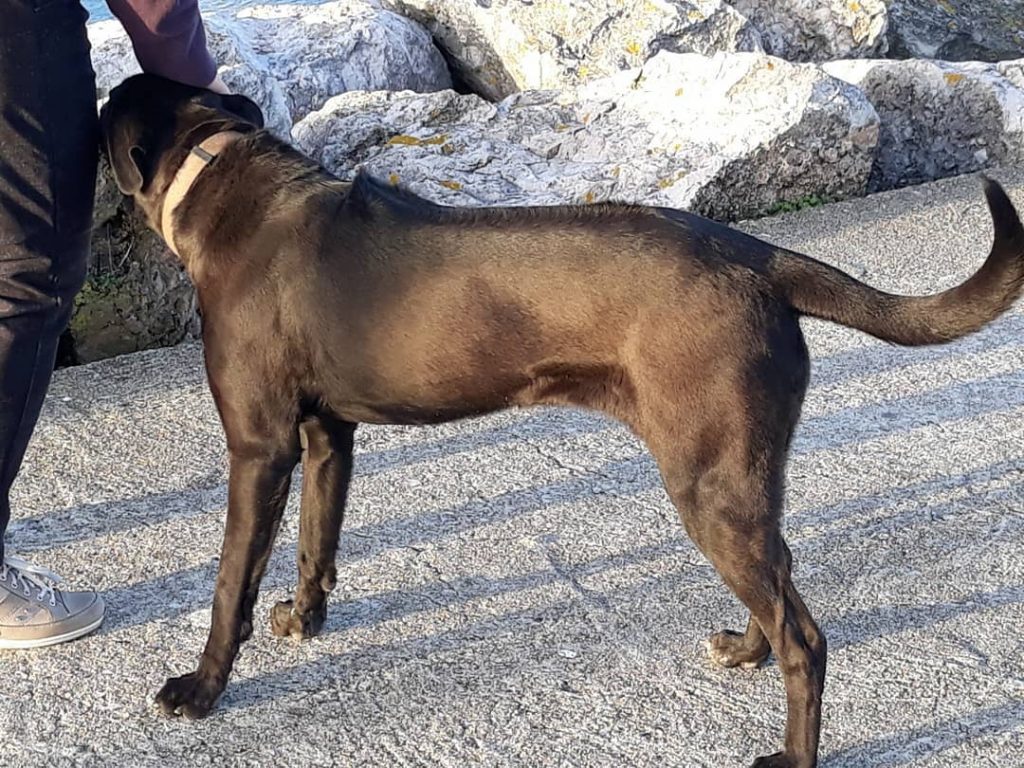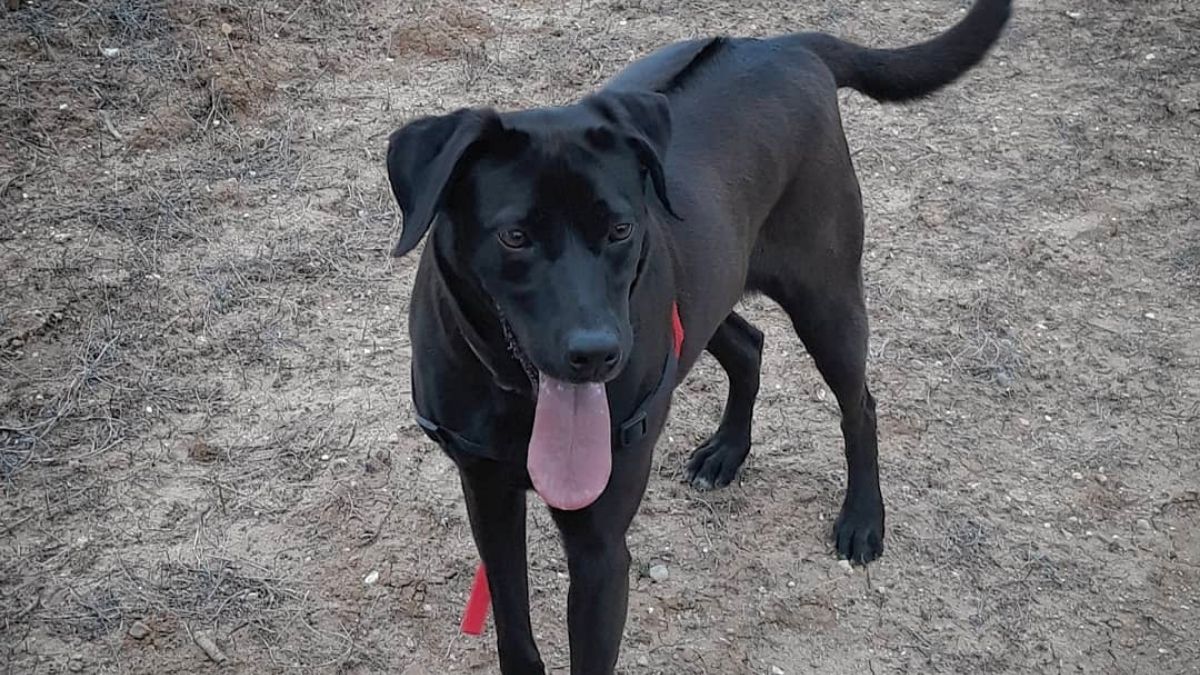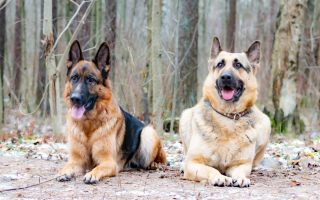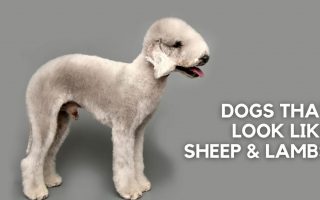The Rhodesian Ridgeback has done a good job at drawing people’s attention.
It is currently among the top 50 most popular breeds in the United States.
And as more people look for unique guardians and companions, it won’t be a surprise if this breed’s ranking moves upward in the coming years.
The American Kennel Club recognizes only Wheaten as the official color of the Rhodesian Ridgeback.
Wheaten comes in different shades, ranging from light to red. Black should only be found on the nose and sometimes on the ears and around the eyes.
However, there has been a slow introduction of solid black Rhodesian Ridgebacks.
Of course, that comes as a surprise to purists, and you can imagine the controversies that follow these black Ridgebacks.
Some of us have a knack for the unconventional, though, and few things are as interesting as a dog going off the standards.
Let’s take a closer look at the black Ridgeback and see what we can learn.
Black Rhodesian Ridgeback History
The Rhodesian Ridgeback originated in the southern parts of Africa by Boer farmers.
These farmers aimed at developing a versatile hunting dog that could survive under harsh conditions, protect and be a companion when needed.
The Ridgeback was bred to fulfill this objective.
The ancestors of the Rhodesian Ridgeback were some European breeds (like the Great Dane and the Greyhound) and the Khoikhoi, a native dog with a ridge running down its back.
The ridge was seen as a symbol of a good hunting dog.
The Rhodesian Ridgeback soon began to go on hunting expeditions. It was first instrumental in bringing down bucks, and soon it graduated to holding lions at a corner till the human hunters arrive.
Dive Deeper:
Can A Rhodesian Ridgeback Kill A Lion?
Rhodesian Ridgebacks succeeded a lot at this. That’s why they were dubbed “African Lion Hound”.
Many Rhodesian Ridgebacks were imported into the United States after the 2nd World War. In 1955, the AKC recognized the breed.
Controversies Surrounding the Black Rhodesian Ridgeback
The black Rhodesian Ridgeback is a rare color type, and there isn’t even a broad range of studies on it.
This is most likely because many brushes off the purebred status of the black Ridgeback, preferring instead to classify it as a Rhodesian Ridgeback Weimaraner mix or a Rhodesian Ridgeback Lab mix.
This same controversy surrounds the Silver Labrador Retriever, but the latter is at a bigger proportion.
However, the few black Ridgebacks that have been discovered to have purebred status and are considered true Rhodesian Ridgebacks.
While we can’t deny that there are Rhodesian Ridgeback mixes that could come with black color, it doesn’t apply to all.
The slight problem is the difficulty in knowing which Black Ridgeback is purebred and which is mixed. Your best solution is to see the parents of the pup.
No reputable breeder would turn down the request, especially for a rare color type.
It would be unethical for a breeder to attempt selling a mixed breed as purebred.
Black Rhodesian Ridgeback Color Genetics
With not many studies on the black Ridgeback, we can only offer some hypotheses on how the coloration happened.
To do that, let us look into the color genetics of a standard Rhodesian Ridgeback.
Just like other dog breeds and humans, there are many genes responsible for the physical details we see on a Rhodesian Ridgeback.
The Wheaten color is controlled by a gene, and the color density of the wheaten still draws back to genes. The same with the ridge going down the spine.
Some Rhodesian Ridgebacks have no ridge at all because the gene responsible for it is either absent or recessive.
There is also a gene responsible for the production of melanin in the Ridgeback. This accounts for the black ears, muzzles, and ears.
Now, a complete absence of melanin in a dog would lead to albinism, but what would happen if the gene-producing melanin goes beyond its job description?
Therein lies our hypothesis.
Rather than claim, that there is a particular gene responsible for the black color, we suggest that an influx of melanin diluted the wheaten color to take on a very dark shade, which we then see as black.
Is the Black Rhodesian Ridgeback Recognized by Kennel Clubs?
Wheaten in all its various shades is the only acceptable for a Rhodesian Ridgeback that wants to compete in a show.
So, good luck trying to register your black Ridgeback in a competition. This color type is best reserved for a family pet or household guard dogs.
The black Rhodesian Ridgeback might only be registered as a “dark wheaten”, not solid black.
You might also need to bring proof of its purebred status to ascertain that your black Ridgeback isn’t a mixed breed.
Appearance

Besides the black color, there is no real difference in the appearance of the purebred black Rhodesian Ridgeback and the standard one.
The size and looks are all the same and depend on the dog in question, not the color.
Male Rhodesian Ridgebacks are usually bigger than their female counterparts.
The typical male Rhodie weighs around 85 pounds and grows up to 25 and 27 inches tall. The female weighs around 70 pounds and grows up to 24 and 26 inches tall.
Many Ridgebacks are recognized by the ridge at their back, but as we’ve pointed out, it can be absent.
This breed has a strong, symmetrical body with a hard back and firm legs.
It has a long neck and a flat skull, brown eyes and a black or brown nose, a long muzzle, and ears that slightly droop.
Its coat is short, shiny, and doesn’t emit odor.
Temperament
Because the black Rhodesian Ridgeback is somewhat of a mystery and black is a symbol of danger to many, some might think a black variant will be more ferocious than the standard Ridgeback.
However, there’s nothing to support this belief. Temperament isn’t influenced by coat colors, but by factors like environment, age, and training.
The Ridgeback is an independent and courageous breed. Its independence stands side by side with high intelligence.
Not surprisingly, this breed would want to do things on its own. It needs a firm and experienced owner.
First-time pet parents will do better with another breed.
A Rhodesian Ridgeback puppy is often all over the place, but when it becomes an adult it turns into a quiet breed.
Rhodesian Ridgebacks are loyal to their families and could even be affectionate, but they are not chummy around strangers.
Because of their aloofness, some people fear this breed. However, only a badly trained Ridgeback will develop aggression towards humans.
With a well-trained Rhodie, only stray cats should be worried.
Exercise Requirement and Training
The Rhodesian Ridgeback has a moderate energy level, and from all indications, the black Ridgeback is the same.
This breed can cope in any environment, including an apartment.
However, that it is calm doesn’t mean you shouldn’t exercise regularly. It would be a mistake to neglect its exercise needs.
The Rhodesian Ridgeback needs a minimum of 2 hours of exercise every day. This could be done at a go or divided into two times based on your schedule.
Exercise can consist of a long walk, mobile sports like biking, or some playful exercises like a frisbee.
This breed should also be mentally stimulated to prevent boredom.
Training and socialization are other needs that this breed should not go without.
It is a trainable breed, but you should be firm as its independent nature makes it want to do things its own way.
You can’t also afford to be harsh towards it, which is where patience is essential. Use positive reinforcements to get it to co-operate.
Obedience training is important for this breed, especially when you need to keep it from bolting off after prey. Teach it basic dog commands and be assertive while at it.
You should also take your Rhodesian Ridgeback out to meet new people and places.
Without proper socialization, its aloofness can become aggression.
Grooming Need
The Rhodesian’s smooth coat is easy to groom, regardless of color. Due to the hot African environment, the coat was bred to suit the summer.
During winter, get warm clothing for your Ridgeback dog. Notwithstanding the short coat, the Rhodesian Ridgeback sheds a lot.
It is therefore not hypoallergenic, despite its odorless nature.
During shedding moments, it will need regular brushing. But that’s the only time you’d need more effort.
On a normal day, you only need to brush once a week and then clean the coat with a damp coat.
Bathing is not necessary unless your dog falls into the mud and gets very dirty.
Other grooming needs are teeth brushing, nail clipping, cleaning the areas around its eyes, and taking care of the ears.
Health and Nutrition
Rhodesian Ridgebacks have a fairly long life span of 10 to 12 years.
They are known to be healthy during this period, and when well-bred shouldn’t give you too many issues.
That said, here are some illnesses to take note of when pet parenting this breed:
Hip Dysplasia
This is one of the most common illnesses to affect dogs. It is usually hereditary and shows up when the dog has grown enough.
Hip dysplasia is caused by a malformation of the hip joint, where the thighbone doesn’t fit as it should.
The joint then degenerates, leading to other complications like arthritis.
Symptoms include limping, a reluctance to move or exercise, and a display of pain.
Elbow Dysplasia
Like Hip dysplasia, elbow dysplasia is a joint-related deformity. It is also hereditary and is known to affect large dogs more than small dogs.
It can lead to lameness if not treated. The symptoms of elbow dysplasia are similar to those of hip dysplasia.
Dermoid Sinus
Dermoid Sinus is a skin problem that’s just as genetic as the above-mentioned dysplasia.
This breed is prone to dermoid sinus, though it can affect other dogs. It is referred to as a neural tube defect and it occurs on the dog’s back, tail, and neck.
You can know that your dog is suffering from Dermoid sinus if you notice an opening on its back with the hair in a swirl.
Dermoid sinus can also cause infections and even a discharge.
Buying or Adopting a Black Rhodesian Ridgeback Puppy
The black Rhodesian Ridgeback puppy is hard to find because of its rarity, and you might need to wait for some time before finding an available one.
There isn’t any fixed price, but breeders would probably sell it higher than the standard one.
The Rhodesian Ridgeback price is between $1,700 and $2,500. You can expect to pay more than that for a black Ridgeback puppy.
Many experts warn pet parents to be careful about getting a non-standard puppy, and we agree with that.
In a bid to sell “rare black Rhodesian Ridgebacks,” some breeders can go through unethical methods.
We have already stated one such method above: selling a Ridgeback mix as a purebred black Rhodesian.
There have been no public reports of this happening, but you cannot go wrong if you’re cautious. Getting a reputable breeder is not optional.
You might also find a black Ridgeback pup in a rescue shelter. Tough, but not impossible.
Unconventional dogs sometimes end up being abandoned. Because rescue shelters aren’t profit-motivated, they tend to be more honest.
Still, ensure you get proof that you’re adopting a pure breed.
Should I Get a Black Rhodesian Ridgeback?
There are no differences between the black Rhodesian Ridgeback and the standard variant, so you should expect the same behavior from any of them.
In the right hands, this breed can make good family dogs. They are calm companions who also double as efficient guard dogs and workers. They also tolerate kids.
If you can’t handle a Rhodie, don’t think you would meet anything different in the black color type.
If you’re getting a Rhodesian Ridgeback with the goal of participating in competitions, it isn’t advisable to own the black variant.
If you’re getting one as a pet, then feel free to search for a black Ridgeback if you fancy it.
Are there black Rhodesian Ridgebacks?
While the breed is popular, the black Rhodesian Ridgeback color variant is rare and hard to find.
There aren’t too many in the United States and other parts, but that might change as the years go by.
Is black a standard Rhodesian Ridgeback color?
The Rhodesian Ridgeback has only one standard color: Wheaten.
Black is not considered a standard color and if any purebred black Rhodesian Ridgeback gets registered under the kennel clubs, it would not have a separate category.
Is black Rhodesian Ridgeback aggressive?
No Rhodesian Ridgeback was bred to be aggressive towards humans, that includes the black variant.
Only poor training can make this breed develop aggression.
Bottom Line
Owning a black Rhodesian Ridgeback is a good way to start a conversation with a fellow dog enthusiast.
Mystery and controversy surround this breed’s variant, and the focus on them has been low.
Hopefully, that would change in the nearest future and more black Rhodesians will grace the earth. We need more novelty, after all.
If you have a black Ridgeback, feel free to share your experience with us and send in some pictures we can share with the doggy community.
Featured Image: Instagram







